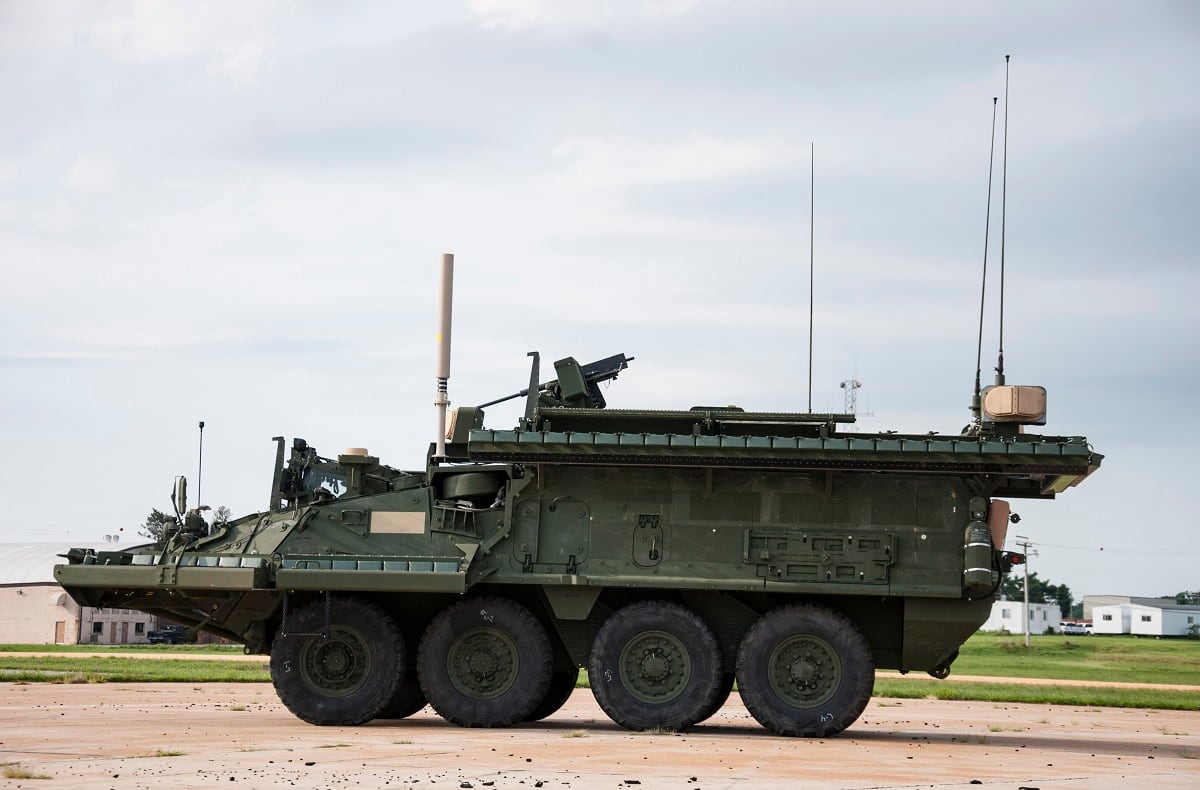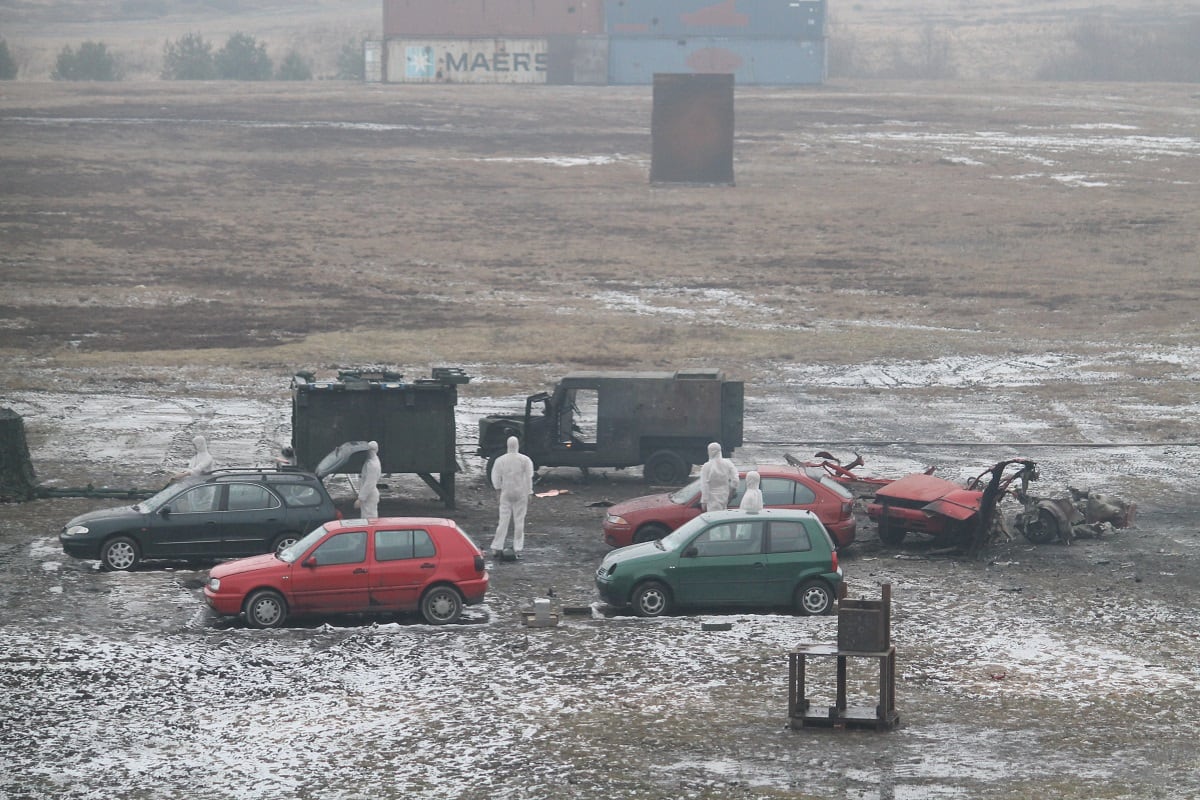WASHINGTON — While the U.S. Army has been working to qualify a Virginia-based company’s active protection system for the Stryker combat vehicle, it is also in the process of evaluating several additional APS solutions for the platform beginning in November.
“The Army will be executing a fourth non-developmental APS system evaluation,” Army spokeswoman Ashley Givens told Defense News in a recent statement. The evaluation will be on the Stryker platform, she confirmed, adding that the service has received three responses to a request for information released earlier this year asking for more Stryker-focused APS solutions.
“At this time the Army is still reviewing the proposals of the vendors to confirm viability,” Givens said.
More than a year ago, the Army determined it needed to field an interim APS solution for the Abrams tank as well as the Stryker and Bradley. The service decided to rapidly assess off-the-shelf APS systems to fulfill an urgent operational need after failing — over a 20-year period — to field an APS capability.
The Army has since selected three different systems: Israeli company Rafael’s Trophy system, which is deployed in the Israeli army, for Abrams; Iron Fist from IMI, another Israeli company, for the Bradley; and Herndon, Virginia-based Artis’ Iron Curtain for Stryker.
While the Army has stayed on track with Abrams, due to a combination of earlier funding availability and qualifying an already fielded system, it has struggled to stay on schedule with the other two configurations.
RELATED

In January, Col. Glenn Dean, the program manager for Stryker, who also manages the service’s effort to install APS on combat vehicles, told Defense News that Iron Curtain’s delay was partly due to a decision to replace the radar originally intended for the APS.
“We’ve had some other issues," he said. "We have learned that that system probably is not as mature as originally envisioned, so the contractor had some difficulty getting to the point they were ready to start characterization, and then we had some, I will call it, friction on the test range.”
At the time, Iron Curtain had roughly three weeks of testing left to wrap up government characterization. Dean said the program office would be ready to generate final reports and bring it to the Army for a decision in the March time frame.
In April, the Army released a sources-sought notice looking for other APS solutions for Stryker and also received, in fiscal 2018, $25 million to qualify a fourth system as part of the interim APS program being called the Expedited Active Protection Systems activity.
According to Givens, the program office has completed the installation and characterization phase of the ExAPS activity, but “we are currently awaiting an Army decision on the next phase of activity for Iron Curtain.”
The Army’s evaluation process of additional systems is expected to come in the form of a live-fire “rodeo” — for lack of a better term — where the service has invited a small number of the RFI respondents with the most promising potential solutions to have their APS capability put to an initial limited test against a set of threats defined by the Army, according to a source familiar with the effort.
The respondents are required to fund the demonstration primarily at their own cost, but some Army funding will be used to conduct the tests.
At least two companies have been invited to participate in the rodeo, the source said.
One those companies is likely Germany’s Rheinmetall. The company has advocated hard for the Army to also qualify its Active Defense System, and the Army admitted, prior to receiving FY18 dollars, that it would want to qualify ADS if it had the funds.
RELATED

Rheinmetall is partnered with Michigan-based Unified Business Technologies, Inc. — or UBT — on the ADS design and integration efforts in the states. Former Army acquisition czar Heidi Shyu and Scott Davis, the now-retired program executive officer for the Army’s ground combat support and combat service support office, serve on UBT’s board of directors.
“ADS would be at the top of the list,” Dean said in January. “It was really close in the design runoff between it and Iron Fist, and we ultimately selected Iron Fist — and there were other competitor systems.”
Meanwhile, Iron Fist live-fire and automotive characterization on the Bradley is still ongoing. “The delays have been attributed to weather delays at the range,” Givens said. “The Iron Fist decision is planned for [the first quarter of FY19].”
And while the service progresses on a decision for an APS for Bradley, it is also attending a demonstration in Israel in two weeks of Rafael’s Trophy VPS — a lighter version of the Trophy system going on the Abrams tank — on a Bradley Fighting Vehicle.
While Rafael chose Bradley for the demonstration because of its availability as a platform, its Trophy VPS can also be integrated onto Stryker and other lighter combat vehicles, the company has said.
“Army leadership will also attend Rafael’s Trophy Lite demonstration in August and pending the results of the demonstration and U.S. government analysis, it may consider pursuing as an alternative APS solution,” Givens said.
Jen Judson is an award-winning journalist covering land warfare for Defense News. She has also worked for Politico and Inside Defense. She holds a Master of Science degree in journalism from Boston University and a Bachelor of Arts degree from Kenyon College.






